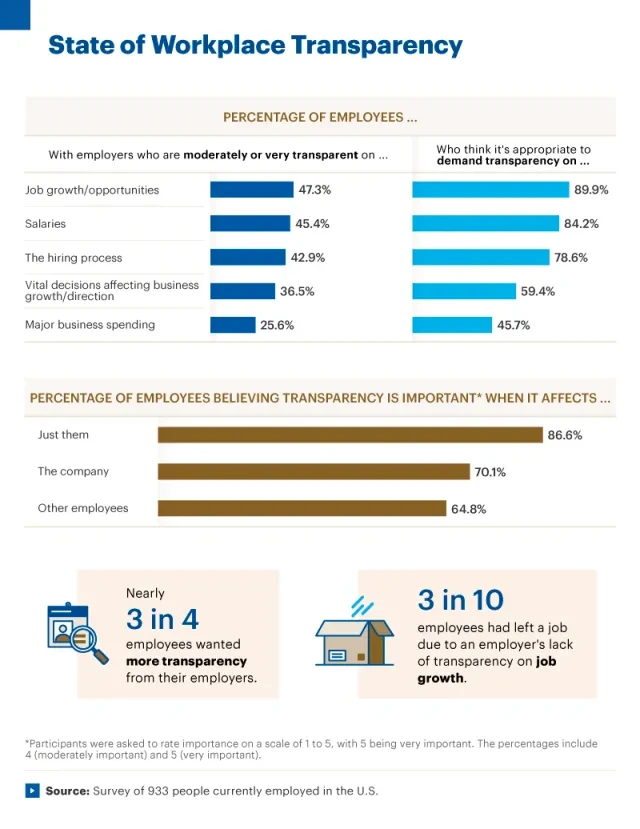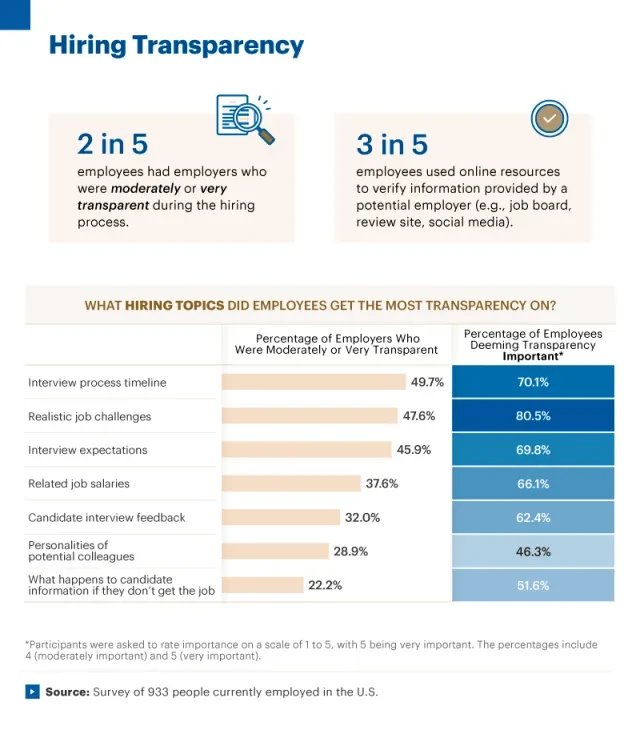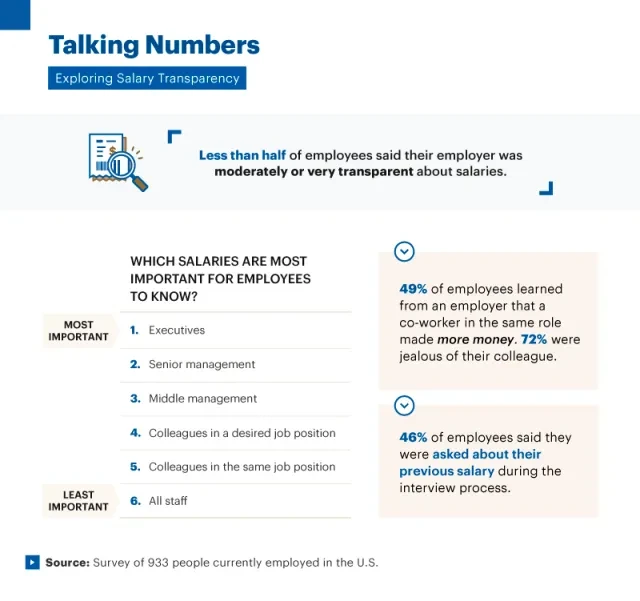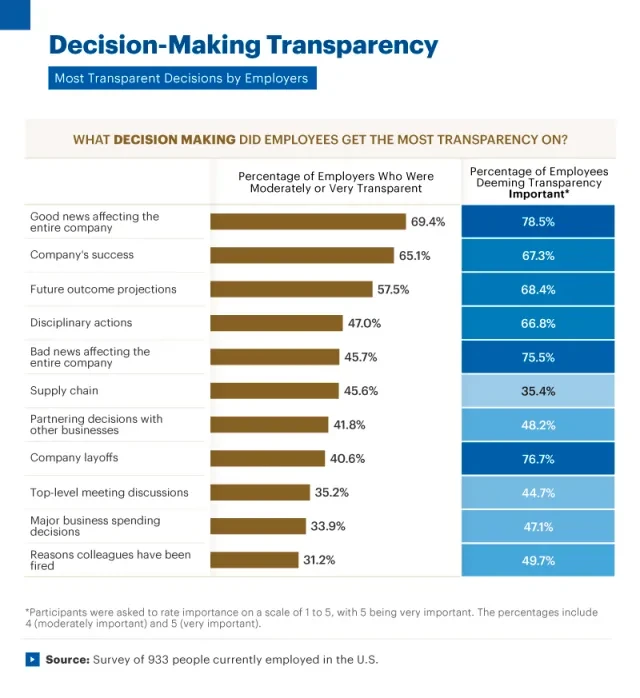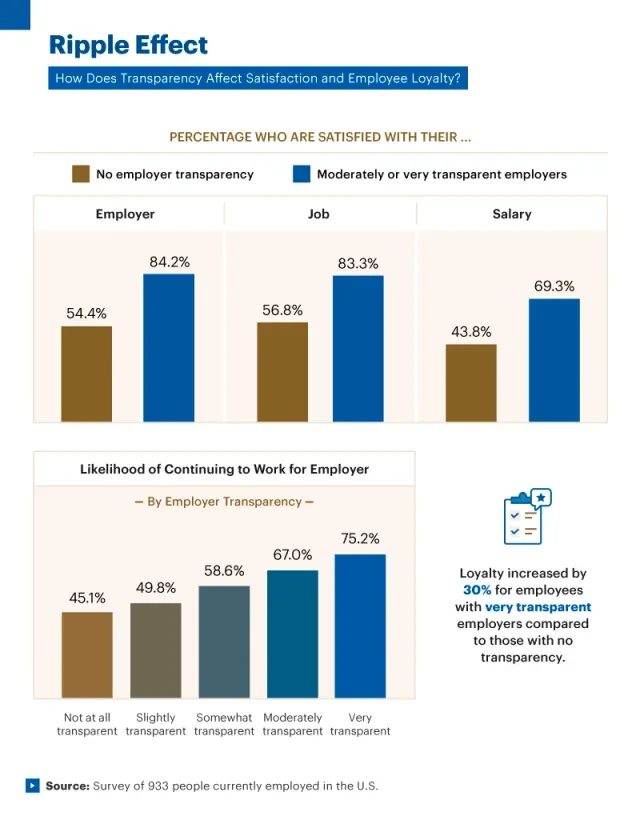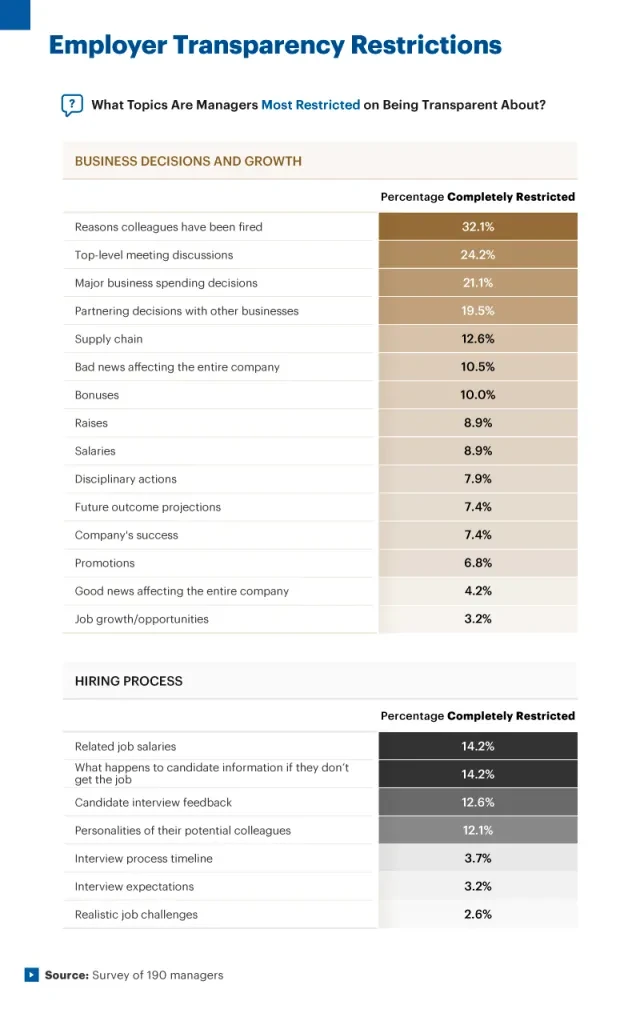Conversations around pay have gained attention recently. But the issue of transparency in the workplace doesn’t stop at salaries. From the interview process to company decisions, are businesses upfront about things like meeting discussions, reasons for layoffs and terminations, or the overall success of the company? We surveyed over 1,100 U.S. employees and nearly 200 managers to gauge how transparent employers are and how accountability impacts the workplace. Keep reading to see what we found.
Demanding the truth
“Honesty is the best policy” applies to nearly every area of life, including business. When it comes to company transparency, sharing information can lead to a stronger, more cohesive team, facilitate goal setting, and flatten company hierarchy, as well as make employees happier. According to our study, employers were the most transparent about job growth and opportunities, salaries, and the hiring process. However, less than 50% of employees said their employer practiced transparency in each area.
Nearly 90% of employees thought it was appropriate to demand transparency regarding growth and opportunities, while 84.2% and 78.6% thought it was appropriate to demand information about salaries and the hiring process, respectively.
Transparency can affect the entire company, regardless of what’s being shared. However, employees thought transparency was most important when it affected them directly. Compared to just 64.8% caring about transparency when it affected their colleagues, 86.6% thought openness was important when it affected only them. Transparency may also be imperative for retaining workers: In fact, 90% of millennials said they would happily commit to a company for 10 years if their employer was clear about salary and status progression.
From the beginning
While many aspects of the hiring process are kept between those involved in the decision, 2 in 5 employees reported that their employer was moderately or very transparent about the hiring process.
While employees were most concerned about realistic job challenges, employers were the most transparent about the timeline for the interview process. However, employers were the least transparent about what happens to candidate information if they aren’t offered the job — something that could pose a significant threat to personal data security. Considering most job applications ask for personal information, often including Social Security numbers, it is vital for applicants to know what information is necessary to provide and that it’s safe with potential employers.
It’s recommended that job seekers keep their Social Security number off online portals and provide it directly to the company instead. Withholding sensitive information is understandable, but Social Security numbers are necessary to complete background checks and ultimately hire applicants. Keeping track of the information provided to each company can also help potential employees stay ahead of any potential data breaches.
It pays to be honest
Despite some companies starting to share salary information, talking about income can often make people uncomfortable. However, these discussions can lead to both small- and large-scale change across the workforce.
But money talk has both upsides and downsides. Knowing a co-worker in the same position makes more money could pit employees against each other. In fact, 72% of employees in this situation were jealous of their co-worker, which can lead to tension and a decrease in satisfaction and productivity.
However, employees weren’t all that concerned with their co-workers’ salaries as much as those above them. When ranking the importance of pay transparency, salaries of colleagues with the same job or role and salaries of all staff were the least important. Rather, employees surveyed thought the salaries of executives and senior management were the most important to know.
Bearing bad news
As a leader at a company, delivering good news can be fairly easy — gathering employees to share in a celebration or success can make these conversations positive ones. Nearly 70% of employers were moderately or very transparent when sharing good news that affected the business, while 65% adequately shared how successful the company was.
Delivering bad news, on the other hand, can be significantly trickier. Whether it’s regarding the company downsizing or potential layoffs, being completely transparent can be difficult. While 75.5% of employees thought it was important to know about bad news that affected the whole company, only 45.7% of employers were extremely transparent about it. Similarly, nearly 77% of employees reported wanting to know about company layoffs, but only 40.6% of employers shared that information. Bearing bad news may be difficult for employers, but there are ways to deliver it with a level of respect and appreciation that employees deserve.
Impact of transparency
Gaining years of experience at one company used to be the standard, but as the workforce evolves, and job-hopping could lead to more money in employees’ pockets, loyalty can be harder to come by. But keeping employees happy enough to stick around isn’t all about the money, benefits, or perks.
Transparency with employees can also play a major role in their satisfaction and commitment: Compared to just 54.4% of employees satisfied with their employer when transparency wasn’t present, 84.2% of those with very transparent employers were satisfied. Job satisfaction had a similar pattern, with 83.3% of employees satisfied with their job when their employer was transparent, and only 56.8% reporting job satisfaction when their employer lacked transparency.
Considering the relationship between job satisfaction and loyalty, 75.2% of employees with very transparent employers said they would stay with their current job, compared to just 45.1% of employees who said they work for nontransparent companies.
How much you share
From the employee perspective, being transparent may seem like an easy thing to do. But there are often decisions or aspects of the business that employers can’t necessarily discuss. While job growth and opportunities, along with good news and promotions, were the least restricted topics, nearly one-third of managers said they were completely restricted from revealing why colleagues were terminated. Discussions at important top-level meetings and major business spending decisions were also completely restricted for 24.2% and 21.1% of managers, respectively.
When it came to transparency throughout the hiring process, managers were the least restricted when revealing realistic job challenges, interview expectations, and the timeline for the interview process. Salaries and candidate information disposal topped the list as the most restricted, with 14.2% of managers each saying they were completely restricted from being transparent regarding these topics.
While companies often differ in transparency and what topics are completely off-limits, there are specific things that upper-level employees and employers should never share, such as personal information, whether about themselves or their colleagues.
No secrets here
Honesty in the workplace may not be a documented policy, but sharing information with employees when possible is vital to keeping them happy, productive, and loyal. From the start of the hiring process to salaries, there are plenty of opportunities for companies to share the truth.
However, while transparency is an overwhelmingly good thing, there is a right and a wrong way to go about it. Employers should know where to draw the line and how to effectively deliver information — both good and bad.
Creating a healthy work environment and aiding employers in running a successful business is our mission at Paychex©. Whether your business is looking to fully outsource human resources and payroll, or you’re simply looking for ways to improve your company, we’re here to help. To learn more, visit us online today.
Methodology and limitations
The data were collected via a survey using the Amazon Mechanical Turk platform. A total of 1,123 U.S. participants were either currently employed part time, full time, or in a managerial role. There were 933 employees and 190 managers.
To gauge transparency, participants were asked to rate their employer’s transparency on a scale of 1 to 5, with 1 being “not at all transparent” and 5 being “very transparent.” For the graphic titled “State of Workplace Transparency,” responses on the transparency scale of 2 to 5 were grouped to represent “transparency to some degree.”
Hypotheses were not statistically tested. As such, this research is purely exploratory. Future research could aim to explore more thoughts on transparency from an employer’s perspective, or it could dive into the topics presented here, such as hiring, salary, and decision-making transparency.
Sources
- Are Tech Companies Breaking The Law With Pay Secrecy Policies?, Forbes, 2018.
- 10 Things Transparency Can Do For Your Company, Forbes, 2018.
- Why Do Employers Keep Salaries Secret, Forbes, 2018.
- See How Your Salary Compares, The Wall Street Journal, 2019.
- 5 sneaky hiring secrets employers don’t want you to know about, CNBC, 2019.
- 21 surprising behaviors that affect whether you get hired after a job interview, Business Insider, 2020.
- Should You Share Your Salary With Co-Workers? Here’s What Experts Say, TIME, 2018.
- The Motivating (and Demotivating) Effects of Learning Others’ Salaries, Harvard Business Review, 2018.
- Layoffs on the Horizon? How To Lead Through a Reduction in Workforce, Forbes, 2018.
- Job-hopping is on the rise. Should you consider switching roles to make more money?, NBCUniversal Media, LLC, 2018.
- The Truth About Employee Loyalty and 5 Things Every Leader Should Know, Forbes, 2019.
- Transparency Is Great–But There’s Still 1 Thing You Should Never Discuss With Employees, Inc., 2018.
- Ten Things Never Ever To Tell Your Coworkers, Forbes, 2017.
- Benefits Rock, but Money Still Talks, Paychex, 2017.
- Conducting Difficult Conversations with Employees, Paychex, 2020.
Fair use statement
Sharing information is clearly beneficial to employees and employers, so we don’t want to hold you back from sharing this project. The graphics and content found here are available for noncommercial reuse. We just ask that you please link back to this page to give the authors credit.









